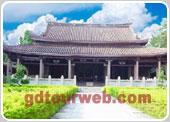1) Confucian revival


儒学的复兴
1.
The trend of " Confucian revival has caused troubles in the cultural choice in China.


“儒学的复兴”思潮给我国的文化选择带来了极大的干扰。
2) revival of Confucianism


儒学复兴
1.
Random Thoughts on Revival of Confucianism——on the Tendency of the Development of Chinese Culture;
儒学复兴新论——兼谈中国文化发展的路向
2.
The revival of Confucianism before and after Anshi Rebellion in the Tang Dynasty;


安史之乱前后的儒学复兴思潮与文体革新
3.
The changes of the prose in Tang Dynasty are gone with the revival of Confucianism.


唐代散文的变化是随着儒学的复兴一起变化的,分三个阶段,重儒兴学,文质初变阶段;儒、释、道并重,骈散相间;儒学复兴,古文运动。
4) the renaissance of Confucianism


儒学复兴论
1.
The basic theoretical propositions of modern Neo-Confucianism may be generalized as follows: Confucianism as the main-stream scholarship, as the orthodoxy, as the new doctrine of “sage within and kingly without", as the doctrine of self limited conscience, as the renaissance of Confucianism, etc.
现代新儒家的基本理论主张可概括为 :儒学主流说、儒家道统说、新内圣外王之道、良知自我坎陷说、儒学复兴论。
5) Refutin the Theory of the Revival of Confucinnism


驳"儒学复兴说"
6) the Revival of the Confucian Thoughts


儒家思想的复兴
1.
Zhang Junmai s Treatise on China s Modernization And the Revival of the Confucian Thoughts;
张君劢论中国现代化与儒家思想的复兴
补充资料:海阳县儒学宫

海阳县儒学宫
海阳县儒学宫位于潮州城区昌黎路和文星路交界处。俗称红学、学宫。始建于南宋绍兴年间,景炎三年(1278),后毁于火。明洪武二年(1369)重建大成殿,虽历经沧桑,其主要建筑大成殿仍完整地保留了明初粤东地区殿堂建筑的风貌特点,以后历代屡有增建,始成规模宏大的建筑群。
殿中供孔子及其弟子塑像。宫内现存大成殿、泮池、棂星门、照壁等建筑,只占原来面积的三分之一。其大成殿保留着明代的宫殿式建筑风格,抬梁式屋架由43支大柱支撑,殿周有石栏杆围护。近年来曾重修棂星门、金声门、玉振门和泮池,并嵌有明、清维修学宫碑记6块。学宫是重要的革命纪念地,国民革命军二次东征时的东征军第一师政治部和南昌起义军军官教导团均曾驻扎于此。学宫现为潮州市博物馆馆址。
说明:补充资料仅用于学习参考,请勿用于其它任何用途。